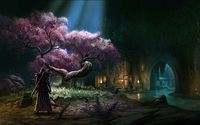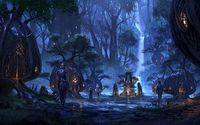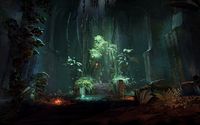Online:Loading Screens/Grahtwood
The UESPWiki – Your source for The Elder Scrolls since 1995
This page contains loading screens from Grahtwood.
Location Messages[edit]
- Root Sunder Ruins - The name of these Ayleid ruins implies they were abandoned because of encroaching tree roots. But the Wood Elves whisper that the sundering roots were not those of normal Grahtwood trees.
- Elden Hollow - When the Daedra-worshiping Ayleids were driven from Cyrodiil after Alessia's Slave Rebellion, many of the Wild Elf clans took refuge in Valenwood. One of the foremost of those clans was granted the right to excavate dwelling-halls under Elden Root itself.
- Grahtwood - This region is the southern heart of the Wood Elves' great forest, and home to more of the gigantic graht-oaks than any other part of Valenwood. Its capital, now also the capital of the entire Aldmeri Dominion, is Elden Root.
- Reliquary Ruins - The official histories of the First Empire state that when Empress Alessia's forces captured White-Gold Tower, all the Ayleids' evil relics of arcane power were taken and destroyed. But Duke Quarl of Twil insisted until his dying day that an Elf King escaped with the chief artifacts.
- Nairume's Prison - Trickster god Rajhin the Footpad, known as the Purring Liar, is much beloved of Khajiiti storytellers. He sends his Seven Shadows into the world to accomplish amazing feats of larceny and stealth.
- The Orrery - "As for the Osseous Orrery: can anyone really claim to comprehend the full intentions of Anumaril in his metamorphosis to instrumentality? Do we even know how many axes of circumpenetration its arms rotate through?" — Morian Zenas, "Commentaries on Beredalmo"
- Cathedral of the Golden Path - Toward the end of the First Era, when Valenwood was ruled by the Second Empire, Southpoint was the most important Imperial colony-town in what was then called the Kingdom of Grahtwood. The cathedral there was built by Governor Zantonius, a Colovian from Kvatch.
- Reliquary Vault - "The most famous burglar in Elsweyr's history, Rajhin is said to have stolen a tattoo from the neck of Empress Kintyra as she slept." — Brother Mikhael Karkuxor, "Varieties of Faith"
- Laeloria Ruins - "Throat of Darkness." That's how the scholars at Arcane University translate "Laeloria." The Wood Orcs at Barkbite Stronghold just refer to it as "the Haunted Pit."
- Cave of Broken Sails - The corsairs of the Southern Sea may not have as fierce a reputation as the pirates of the Abecean, but that's probably because they keep a lower profile, as they must constantly dodge the warships of the Altmer and Maormer. The corsairs may be of any race, but most are Khajiit.
- Ossuary of Telacar - The Altmeri wizard Telacar excavated and occupied this ancient Ayleid ruin, converting it to his own uses. The site's original Ayleid name has been long forgotten.
- The Aquifer - The port city of Haven, on the border with Elsweyr, has changed hands many times. During the late First Era it was governed by the Reman Empire. More recently it has become a sort of High Elf colony. The Altmer replaced the Imperial buildings with their own—but they kept the Imperial sewer system.
- Ne Salas - The Ayleids who fled to Valenwood after the Slave Rebellion were mostly those who worshiped the Daedric Princes, which was outlawed under Empress Alessia. The Slave Queen melded the Aedra worshiped by her human and remaining Elven subjects to create the Eight Divines.
- Burroot Kwama Mine - Expatriates often try to bring beloved aspects of their culture with them when they emigrate. So it was with Llevyn Buratil of Narsis in Morrowind, who tried to establish a kwama mine in Grahtwood. The experiment was less than a resounding success.
- Mobar Mine - With the flurry of construction going on in nearby Elden Root, the Foriniel Brothers have reopened Mobar Mine to supply the builders with clay for making bricks. Strangely, no one has heard from the Foriniels in over a week.
- The Scuttle Pit - The spiders of Tamriel are fearsome carnivores that prey on everything they can catch, even each other. They have adapted to every environment, both above and below ground, and there seems to be no limit as to how large they can grow.
- Vinedeath Cave - The strangler is a carnivorous plant that lurks in the shadows of the forest floor. Its tentacles excrete a sticky, sweet substance that attracts prey. The strangler reacts to warmth and movement by lashing out with its tentacles and drawing what it captures into its hungry maw.
- Wormroot Depths - Regarded by scholars of the arcane as the apex achievement of the Wild Elves' magical art, the so-called Ayleid Wells are believed to use Aetherial crystal to aggregate magicka from starlight—even in subterranean locations.
- The Middens - The Wood Elves' practice of throwing all garbage out their windows to fall at the roots of their tree-houses is regarded by other folk as revolting and unsanitary. The Bosmer say they're fertilizing the roots of their beloved trees, but most others just think they're lazy.
- Elden Root Outlaws Refuge - The outlaws of Grahtwood have secretly excavated and occupied some of the extensive ancient ruins beneath Elden Root. Their chambers demonstrate that, while they may break the law, they still adhere to the Green Pact.
- Grand Topal Hideaway - You probably think only the mad masterminds of vast criminal organizations have their own private tropical islands. Well, think again: you, too, could have a hidden hideaway ever-trembling on the verge of volcanic destruction!
- Lair of Maarselok - The fertile jungles of this mountain valley have long since swallowed up the Khajiit kingdom that once called it home. But a new, malignant growth is spreading here, and it threatens to consume far more than old ruins.





